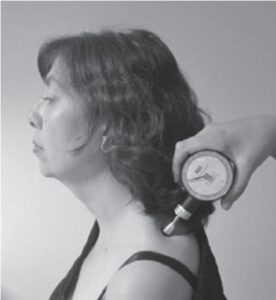Do you experience pain when pressure is applied to a certain area of your body? If so, you may have a condition known as the pressure pain threshold. This is a condition that affects many people and can be quite painful. In this blog post, we will discuss what the pressure pain threshold is. And some of the things you need to know about it. We will also provide tips for how to manage the condition.
Contents
What Is Pressure Pain Threshold?
 Pressure pain threshold (PPT) is a measure of the intensity of pressure needed to cause pain sensation in a person. It represents the point at which gentle touch turns into something uncomfortable or even painful. PPT is an important parameter that helps to assess the level of sensitivity and tolerance to physical stimuli.
Pressure pain threshold (PPT) is a measure of the intensity of pressure needed to cause pain sensation in a person. It represents the point at which gentle touch turns into something uncomfortable or even painful. PPT is an important parameter that helps to assess the level of sensitivity and tolerance to physical stimuli.
More often, this is tested in the context of physical therapy and diagnostic tests, such as measuring touch sensitivity. Doctors or therapists measure PPT by applying pressure to a certain area of the body with their fingertips. And gradually increase the intensity until the patient feels pain.
This can help assess tissue sensitivity, diagnose arthritis and other musculoskeletal conditions, evaluate nerve damage, and determine the effectiveness of treatments. Pressure pain thresholds may be measured in a variety of body parts, including the back, arms, and legs.
How Is Pressure Pain Threshold Tested?
The pressure pain threshold test is an important measure of central sensitization and the pain experience. It is one of the most widely used measures for assessing a subject’s sensitivity to painful stimuli. The pressure pain threshold test involves applying a specific amount of pressure to a specific area. Which is further on the body with a handheld device, such as a pressure algometer, and measuring the subject’s pain response.
Generally, when the pressure reaches a certain level, the individual will experience pain. The amount at which this occurs is referred to as the “pressure pain threshold.” This measurement can be used to help determine how sensitive an individual is too painful stimuli. And can also provide insight into the effectiveness of certain treatments for chronic pain.
What Is The Clinical Significance?
The pressure pain threshold is a measure of an individual’s sensitivity to painful stimuli, which can be useful in diagnosing and treating various conditions, such as chronic pain. It can help healthcare professionals determine the severity and type of pain, as well as its potential causes.
Pressure pain threshold testing is often used in combination with other tests, such as imaging and laboratory tests, to make a more complete diagnosis of a patient’s condition.
Pressure pain threshold testing can also be used to monitor the effectiveness of treatment over time. By measuring an individual’s pressure pain thresholds before, during, and after treatment, healthcare professionals can evaluate the efficacy of a particular treatment.
Additionally, pressure pain threshold testing can help to identify potential risk factors for developing chronic pain conditions. This is because individuals with lower levels of pressure pain threshold are more likely to experience painful stimuli than those with higher levels.
What Are The Benefits?
 When it comes to pain management, there is no denying the importance of pressure pain threshold (PPT). Some of the common benefits of measuring PPT include:
When it comes to pain management, there is no denying the importance of pressure pain threshold (PPT). Some of the common benefits of measuring PPT include:
- Helping to determine the level of pain a person is experiencing. This can be especially beneficial for those suffering from chronic pain. As it enables healthcare providers to design an effective treatment plan that takes into account their individual pain levels.
- Assisting with diagnosis and treatment planning. By measuring PPT, healthcare professionals can more accurately determine the underlying cause of a person’s pain and tailor treatment plans accordingly.
- Monitoring progress. By tracking PPT over time, medical providers can monitor the effectiveness of treatment plans. And make adjustments as needed to ensure optimal results.
It is an important tool for healthcare providers, as it allows them to measure a person’s individual pain tolerance level. And formulate treatment plans that are tailored to the patient’s needs. The test itself is quick and easy, making it an ideal option for those who need to be monitored regularly.
What Does Pressure Pain Threshold Measure?
This is usually a measure of the amount of pressure required to cause pain. It can be measured by using a device that measures the amount of force required to produce a sensation, such as a small algometer or hand-held dynamometer. Pressure pain threshold is commonly used in physical and occupational therapy to assess areas of the body that are sensitive to pressure.
There are some common ways to measure it. For example, the Algometer involves pressing a small metal probe against the skin and applying increasing pressure until a certain level of discomfort is felt by the patient.
The hand-held dynamometer uses a similar method. But instead of a metal probe, it applies pressure via two handles that are pushed together. A similar device is the pressure pain threshold meter, which uses a pressure sensor to measure the force applied to an area of the body. This can be used to measure the sensitivity of different parts of the body.
The results from these tests are important for helping practitioners to determine if patients are experiencing more or less than normal amounts of pain in a particular area.
What Are The Limitations
As it is a subjective measure, there are some limitations of pressure pain threshold measurements.
- For one, the actual amount of pressure used is difficult to standardize as different people can interpret and perceive the same amount of pressure differently.
- Additionally, even if using a device for measurement, there could be variations in how much pressure is applied among operators. This means that it may take longer to get results, as the measurements may need to be repeated.
- The accuracy of pressure pain threshold measurements can also be affected by factors such as age, gender, level of fitness, and emotional state. This means that any changes in these factors could also affect the measurement results.
- Finally, there is a risk of measuring inaccurate results due to the subjective nature of this measurement.
As you can see, it is important to be aware of the limitations of these threshold measurements. This will help ensure that accurate results are obtained. And that any changes in factors such as age, gender, level of fitness, or emotional state are taken into account before getting a result.
It is also essential to use standardized testing conditions and equipment when obtaining the measurement results.
Conclusion
In conclusion, the pressure pain threshold is an important concept to understand in the fields of medicine and health. It is a measure of how much pressure can be put on an area before it starts to hurt. Knowing your own pressure pain threshold can help you to make sure that you take care of yourself. And don’t overexert yourself or push too hard against something that could be painful.
If you are ever unsure about the level of pressure you are applying to your body, it is best to consult with a healthcare professional before engaging in any activities that may cause pain.
Physical Therapy has always been proven to help patients recover from pain. Hence, if you’re experiencing Back pain, Shoulder pain, Knee pain, Neck pain, Elbow pain, Hip pain, or Arthritis pain, a physical therapist at MantraCare can help: Book a physiotherapy session.


